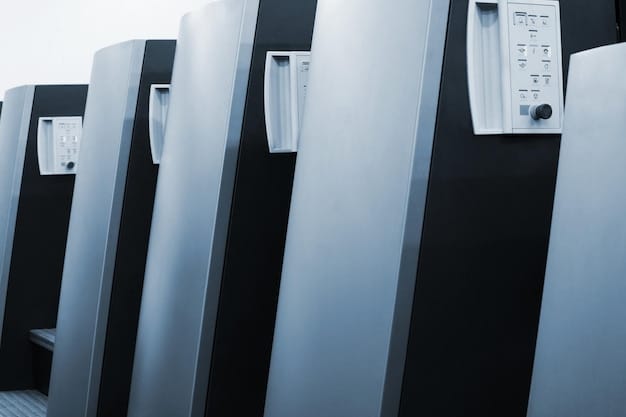How US Businesses Can Benefit from the 30% Energy Storage Tax Credit in 2025

US businesses can leverage the updated 30% federal tax credit for energy storage in 2025 by investing in qualifying technologies like batteries and thermal storage, directly reducing project costs and boosting ROI while contributing to a more sustainable energy future.
The updated 30% federal tax credit for how can us businesses leverage the updated 30% federal tax credit for energy storage in 2025? presents a significant opportunity for businesses across the United States to invest in energy storage solutions, reduce their carbon footprint, and achieve substantial cost savings.
Understanding the Updated Federal Tax Credit for Energy Storage
The federal tax credit for energy storage, updated to 30%, is a crucial incentive designed to encourage investment in technologies that can store energy for later use. This includes batteries, thermal energy storage, and other innovative solutions that help balance the energy grid and reduce reliance on fossil fuels.
What Qualifies for the Tax Credit?
To qualify for the 30% tax credit, the energy storage system must meet certain criteria, including being located in the United States and being used to store energy. The system must also be either connected to a renewable energy source or be used to improve the efficiency of the grid.
Eligible Technologies
Several types of energy storage technologies are eligible for the tax credit. These include:
- Battery storage systems
- Thermal energy storage
- Pumped hydro storage
- Compressed air energy storage
These technologies play a critical role in ensuring a reliable and sustainable energy supply, making them valuable investments for businesses.

The updated tax credit aims to promote broader adoption of these technologies by making them more financially accessible to businesses of all sizes. By understanding the eligibility requirements and the types of technologies that qualify, businesses can strategically plan their investments to maximize the benefits of the credit.
Benefits of Investing in Energy Storage for US Businesses
Investing in energy storage solutions provides numerous benefits for US businesses. Beyond the immediate financial savings from the tax credit, energy storage can improve operational efficiency, enhance grid resilience, and contribute to sustainability goals.
Cost Savings and ROI
One of the primary benefits of energy storage is the potential for significant cost savings. By storing energy during off-peak hours when prices are lower and using it during peak demand, businesses can reduce their electricity bills. The 30% tax credit further enhances the return on investment (ROI) for energy storage projects, making them even more attractive.
Improved Grid Resilience
Energy storage can enhance grid resilience by providing a backup power source during outages and helping to balance the grid during periods of high demand. This can reduce downtime for businesses and ensure a more reliable energy supply.
Sustainability and Environmental Benefits
Investing in energy storage supports sustainability efforts by reducing reliance on fossil fuels and promoting the use of renewable energy sources. This can help businesses achieve their environmental goals and improve their corporate image. The tax credit incentivizes the adoption of these cleaner technologies, contributing to a more sustainable energy future.
Energy storage not only offers financial benefits but also supports broader environmental and operational goals, making it a strategic investment for US businesses looking to thrive in a changing energy landscape.
Steps to Leverage the 30% Federal Tax Credit
To effectively leverage the 30% federal tax credit, US businesses should follow a structured approach that includes assessing their energy needs, selecting the appropriate technology, and understanding the application process.
Assess Your Energy Needs
The first step is to conduct a thorough assessment of your business’s energy needs. This includes analyzing your energy consumption patterns, identifying opportunities for peak shaving, and determining the potential benefits of energy storage.
Select the Right Technology
Based on your energy needs, select the energy storage technology that best fits your requirements. Consider factors such as cost, performance, and scalability.
- Lithium-ion batteries are a popular choice for their high energy density and long lifespan.
- Flow batteries offer scalability and long discharge durations.
- Thermal energy storage is ideal for businesses with significant heating or cooling needs.
Understand the Application Process
Familiarize yourself with the application process for the tax credit. This includes gathering the necessary documentation, completing the application form, and meeting all eligibility requirements. Consulting with a tax professional or energy consultant can help ensure a smooth and successful application.

By taking these steps, US businesses can strategically leverage the 30% federal tax credit to invest in energy storage solutions that drive cost savings, improve grid resilience, and support sustainability goals.
Potential Challenges and How to Overcome Them
While the 30% federal tax credit offers significant benefits, businesses may encounter challenges when implementing energy storage projects. Understanding these potential hurdles and developing strategies to overcome them is essential for success.
Regulatory Hurdles
One common challenge is navigating the regulatory landscape. Energy storage projects may be subject to various local, state, and federal regulations, which can be complex and time-consuming to comply with.
To address this, businesses should:
- Engage with local authorities and regulatory agencies early in the planning process.
- Work with experienced consultants who understand the regulatory requirements.
- Stay informed about any changes to regulations that may impact their projects.
Financing and Investment
Securing financing for energy storage projects can also be a challenge. Although the tax credit reduces the upfront cost, businesses may still need to obtain loans or attract investors to cover the remaining expenses.
Strategies to overcome financing challenges include:
- Exploring various financing options, such as loans, grants, and power purchase agreements (PPAs).
- Demonstrating the long-term ROI of the project to potential investors.
- Leveraging the tax credit to attract financing by showcasing the reduced project cost.
Technology Integration
Integrating energy storage systems with existing infrastructure can present technical challenges. Ensuring seamless integration requires careful planning and coordination with technology providers and contractors.
To mitigate these challenges, businesses should:
- Conduct thorough technical assessments of their existing infrastructure.
- Work with experienced integrators who have a proven track record.
- Implement robust monitoring and control systems to optimize performance.
By proactively addressing these potential challenges, US businesses can successfully implement energy storage projects and fully leverage the benefits of the 30% federal tax credit.
Future Trends in Energy Storage Technology
The energy storage industry is rapidly evolving, with continuous advancements in technology and increasing adoption across various sectors. Staying informed about these trends can help US businesses make strategic investment decisions and maximize the benefits of energy storage.
Advancements in Battery Technology
Battery technology is continuously improving, with ongoing research and development efforts focused on increasing energy density, extending lifespan, and reducing costs. Lithium-ion batteries remain a dominant technology, but other emerging technologies, such as solid-state batteries and flow batteries, are gaining traction.
Integration with Renewable Energy Sources
The integration of energy storage with renewable energy sources, such as solar and wind, is becoming increasingly common. Energy storage can help address the intermittency of renewable energy, ensuring a more reliable and stable power supply. Businesses can leverage energy storage to optimize the use of on-site renewable energy generation, reducing their reliance on the grid and lowering their carbon footprint.
Smart Grid Applications
Energy storage is playing an increasingly important role in smart grid applications. By providing grid services, such as frequency regulation and voltage support, energy storage can enhance grid stability and resilience. Businesses can participate in these programs to generate additional revenue and contribute to a more efficient and reliable grid.
The energy storage industry is poised for continued growth and innovation, offering significant opportunities for US businesses to enhance their energy efficiency, reduce costs, and support a more sustainable energy future.
Success Stories: Businesses Benefiting from Energy Storage
Several US businesses have already successfully leveraged energy storage solutions to achieve significant cost savings, improve grid resilience, and support their sustainability goals. These success stories provide valuable insights and inspiration for other businesses considering similar investments.
Case Study 1: Manufacturing Facility
A manufacturing facility in California installed a battery storage system to reduce its peak demand charges. By storing energy during off-peak hours and using it during peak demand, the facility was able to lower its electricity bills by 20%. The 30% federal tax credit significantly improved the ROI of the project, making it an attractive investment.
Case Study 2: Commercial Building
A commercial building in New York implemented a thermal energy storage system to reduce its cooling costs. The system stores chilled water during off-peak hours and uses it to cool the building during peak demand, resulting in a 15% reduction in energy consumption. The building also benefited from improved grid resilience, as the energy storage system provided a backup power source during outages.
Case Study 3: Data Center
A data center in Virginia installed a flywheel energy storage system to ensure uninterrupted power supply. The system provides instant backup power in the event of a grid outage, preventing data loss and downtime. The data center also participated in grid services programs, generating additional revenue by providing frequency regulation services.
These success stories demonstrate the real-world benefits of energy storage for US businesses. By learning from these examples, other businesses can identify opportunities to leverage energy storage and the 30% federal tax credit to achieve their energy and sustainability goals.
| Key Point | Brief Description |
|---|---|
| 💰 Tax Credit Benefit | 30% federal tax credit reduces project cost. |
| ⚡ Eligible Technologies | Includes batteries, thermal, and pumped hydro. |
| 📊 Energy Assessment | Analyze consumption to identify savings. |
| 🌱 Sustainability | Supports renewable energy and lowers emissions. |
Frequently Asked Questions
▼
Qualifying technologies include battery storage, thermal energy storage, pumped hydro, and compressed air energy storage systems that meet specific requirements, such as being located in the US.
▼
The 30% federal tax credit reduces the upfront cost of energy storage projects, improving ROI and making investments more attractive. It aligns with sustainability goals and lowers energy bills.
▼
Key steps include assessing energy needs, selecting the right technology, and understanding the application process. Consulting with experts is recommended for a successful application.
▼
Challenges may include regulatory hurdles and securing financing. Overcome them by engaging with local authorities, seeking expert consultants, and exploring financing options like loans or grants.
▼
Advancements include improved battery technology, integration with renewable energy, and benefits from smart grid applications. These trends offer businesses more flexibility and opportunities for efficient energy use.
Conclusion
The updated 30% federal tax credit for energy storage in 2025 represents a pivotal opportunity for US businesses to invest in sustainable energy solutions. By understanding the eligibility requirements, assessing their energy needs, and navigating potential challenges, businesses can leverage this credit to reduce costs, enhance grid resilience, and support a cleaner energy future.





